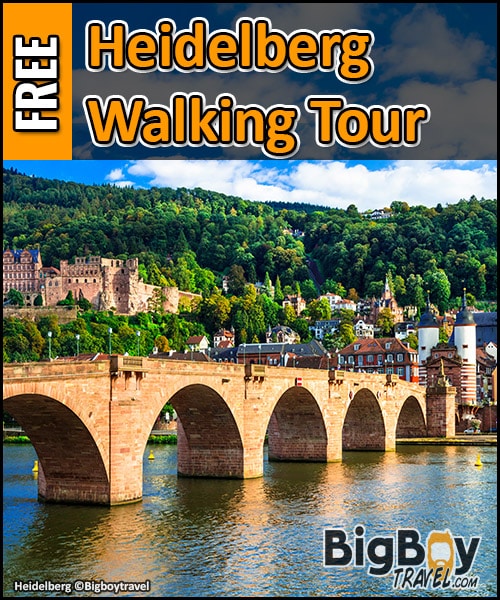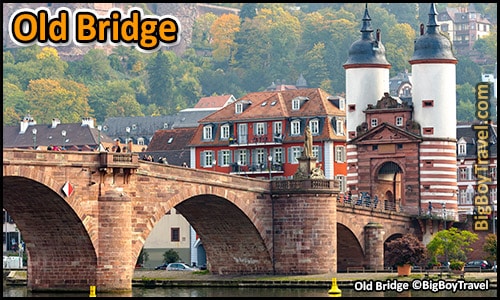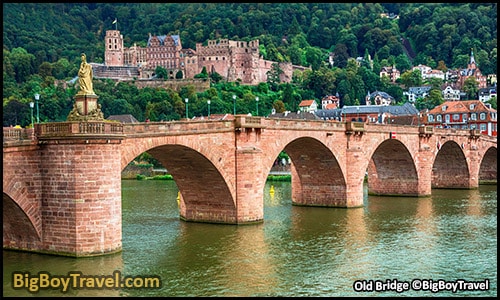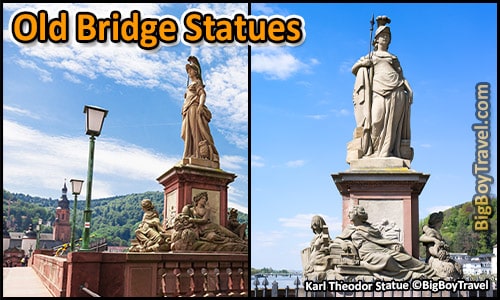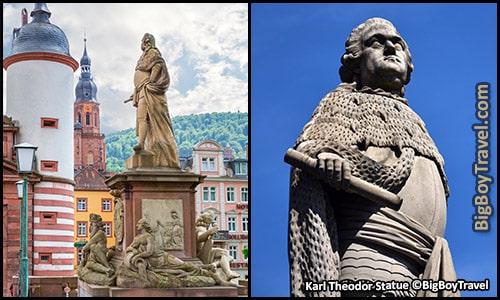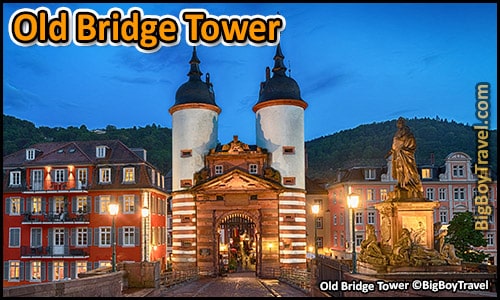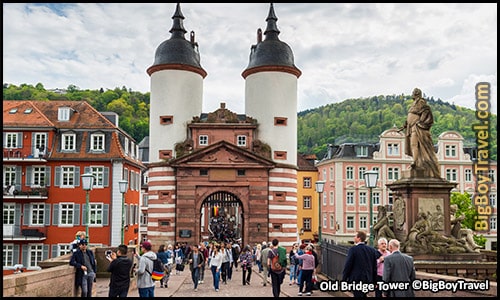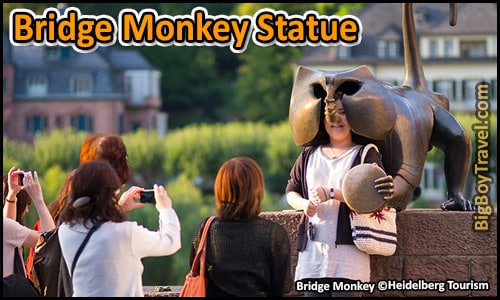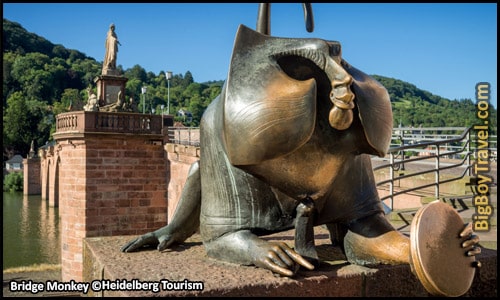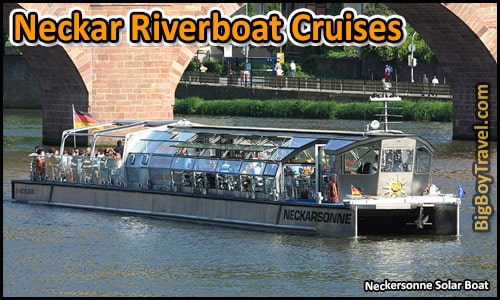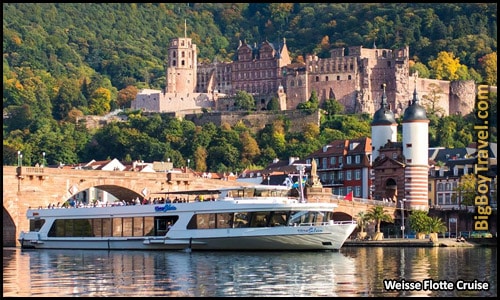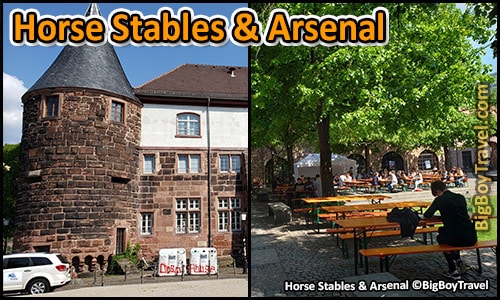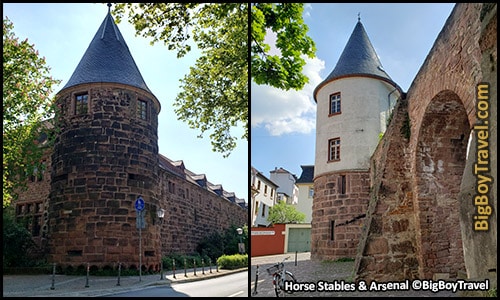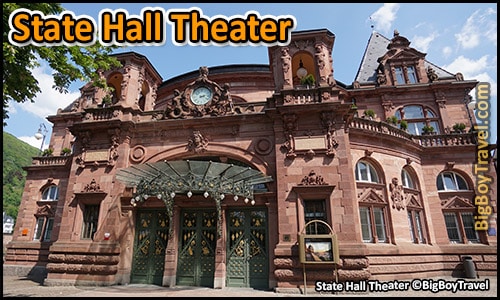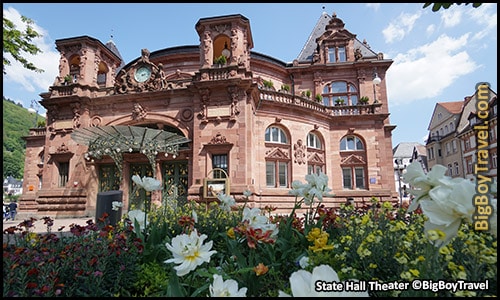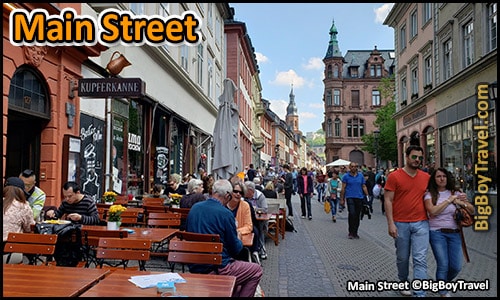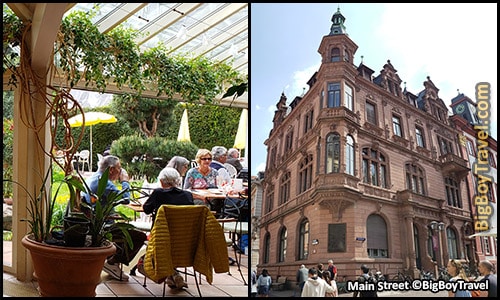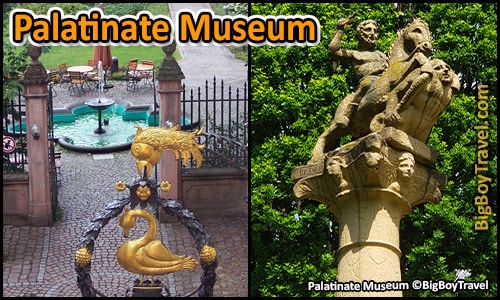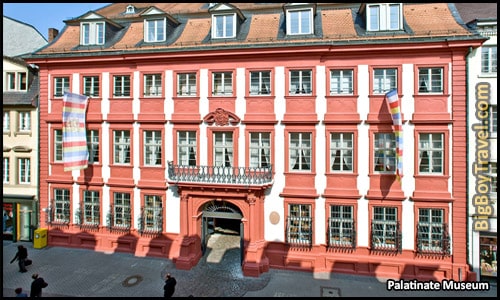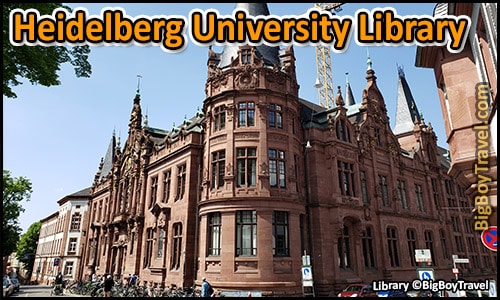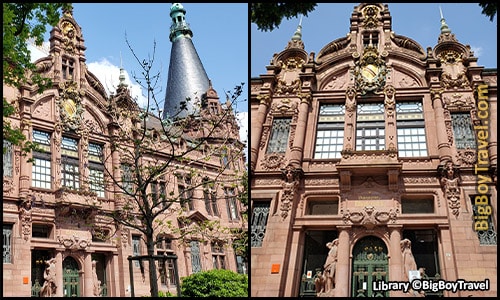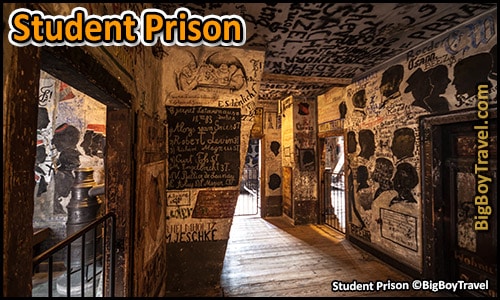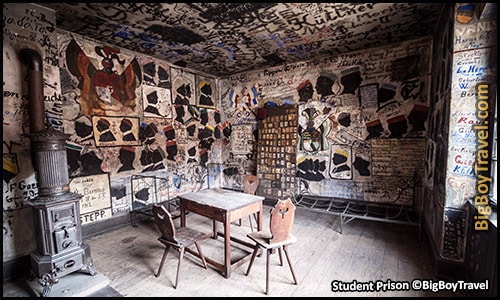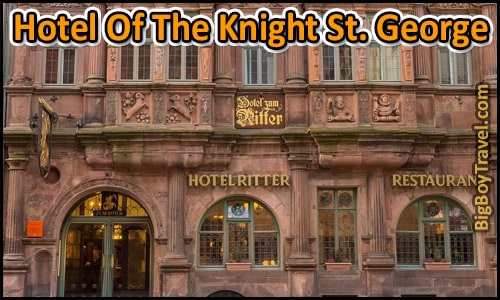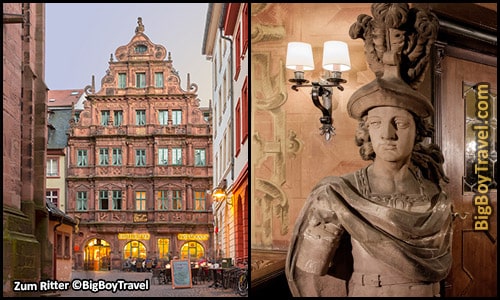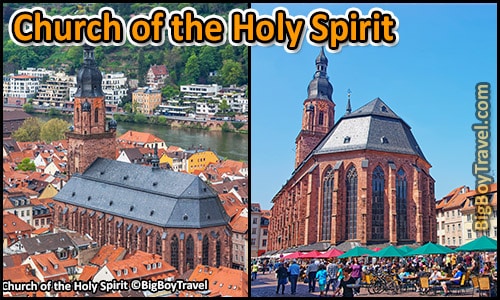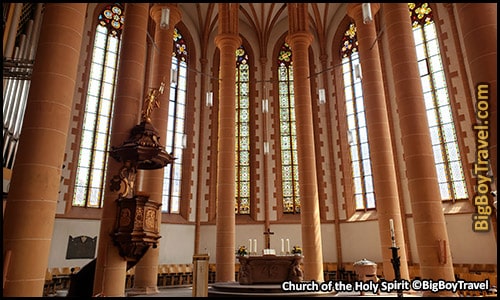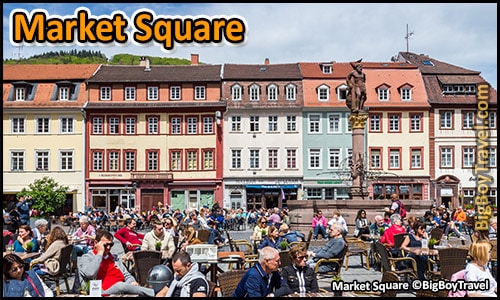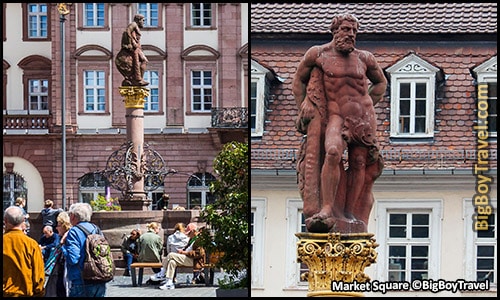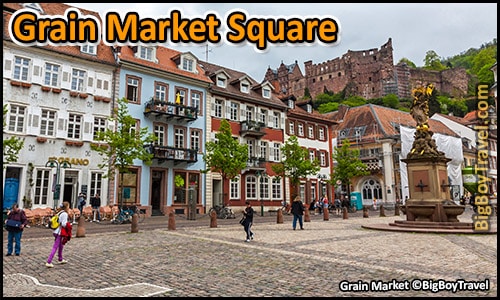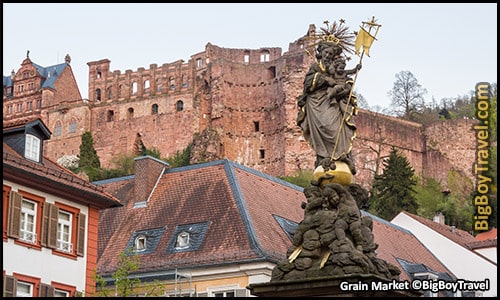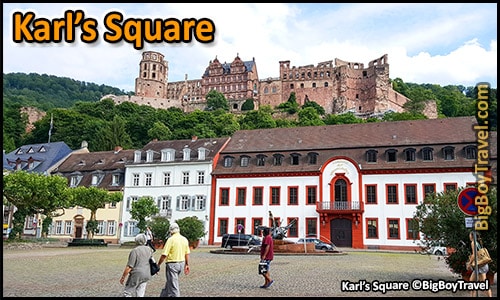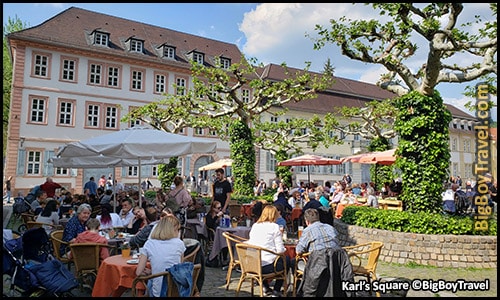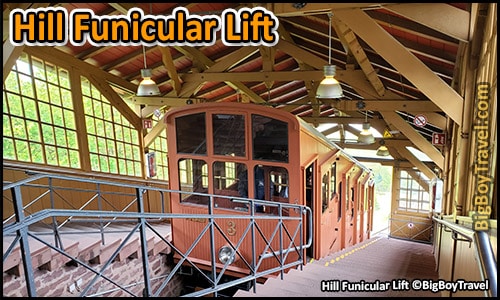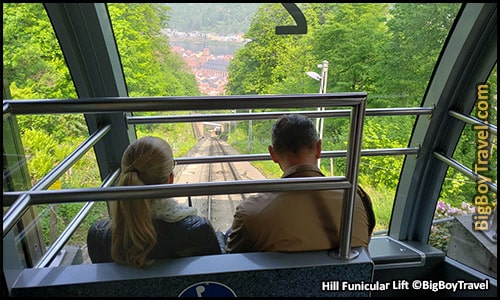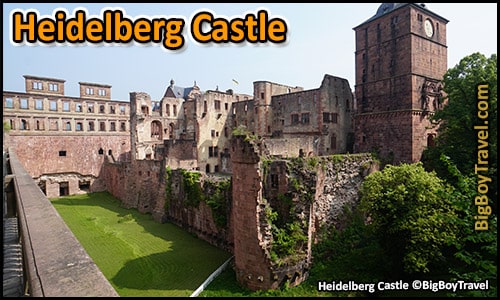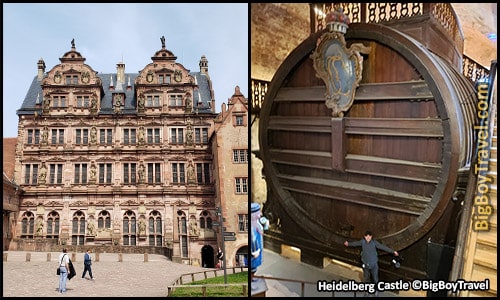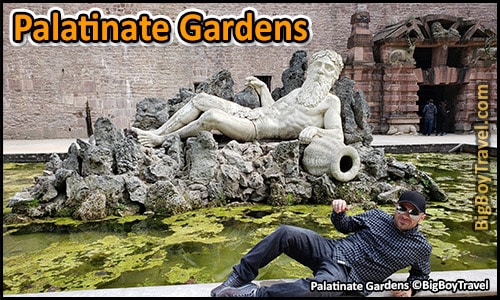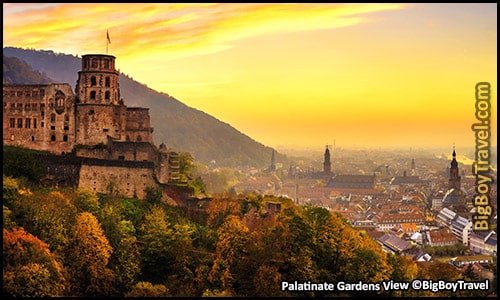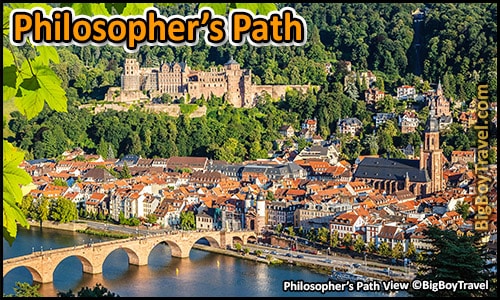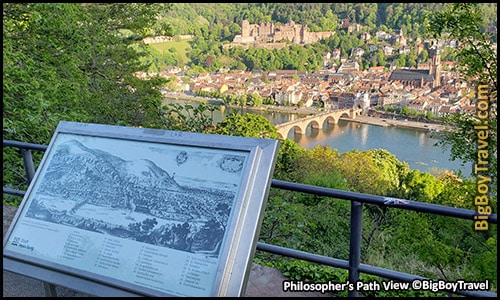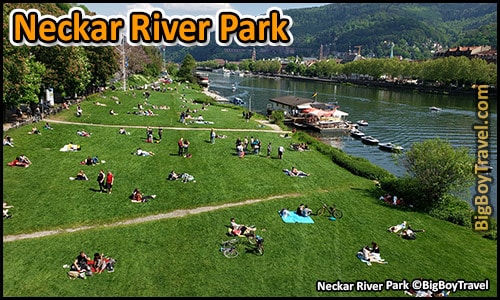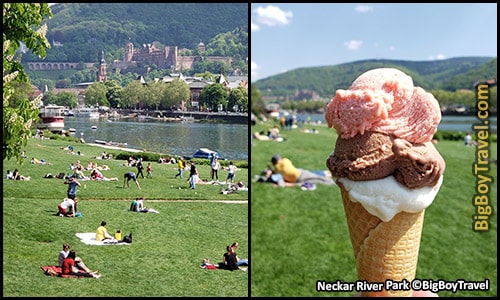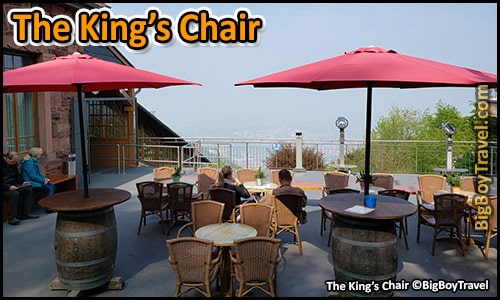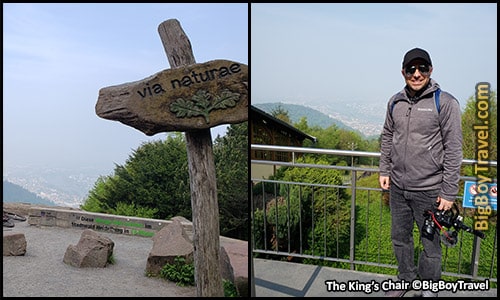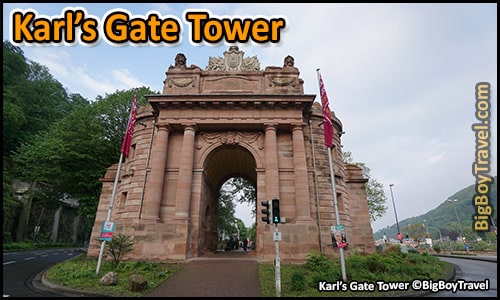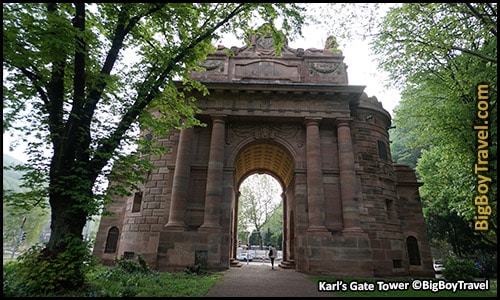Free Heidelberg Walking Tour:
Walking Tour Location: Old Town Heidelberg
Style: Do-It-Yourself Walking Tour (Self Guided)
Start: The Old Bridge (Alte Brücke)
End: Scheffel Terrace (Scheffelterrasse)
Walking Distance: 2.2 Miles (+.5 miles each way for Philosopher’s Path Lookout)
Time: 90 Minutes For Walk (with attractions 5-6 hours)
Fun Scale: 9.5 out of 10
Overview of Old Town Heidelberg:
While the North side of the Neckar River was home to Celtic and Roman settlements, the Southside blossomed in the Middle Ages into the well-preserved Old Town Heidelberg you can tour today. Heidelberg served as the capital of the Electoral Palatinate of the Rhine for 600 years (1085–1690) and was one of the main residences of the powerful Wittelsbach family for just as long (1214–1803).
With powerful standing in the Holy Roman Empire, Heidelberg grew under the shadow of its mighty castle which is still one of the best to visit in Germany. One this free Heidelberg walking tour, we will take you through the sights that shaped Old Town from the impressive castle and Germany’s oldest university (founded in 1386), through Medieval Squares and over one of the most romantic bridges in Central Europe.
Heidelberg Walking Tour:
1a. The Old Bridge (Alte Brücke):
About The Old Bridge: Strolling along the cobblestoned Old Bridge is one of the best things to do on our free Heidelberg walking tour and a great place to get introduced to the town’s history. Further upstream, near the Neckar Park, there was once a single wooden bridge over the river established by the Romans in the 1st Century. The bridge was rebuilt in stone in 100AD, but after it collapsed there wasn’t a new one spanning the Neckar River until 1284. That might sound crazy to have no bridge for 1,000 years but there are surprising a lot of challenges with both flooding and ice along the Neckar River. These problems have also plagued the bridge’s current location of the which is on its 9th version since Medieval times.
The Neckar River once served as the border between the Electorate Palatinate of the Rhine (South) and the Electorate of Mainz (North) which required the bridge to be heavily fortified during the Middle Ages. On Sebastian Münster’s engraved drawings of Heidelberg (Cosmographia) from 1550, we get a glimpse of what the Old Bridge looked like through Medieval times. It shows us that the bridge had a wooden roof over it and in addition to the preserved double-tower gate on the Southern end, it also had the Monkey Tower Gate (Affenturm) on its Northern end.
Most of the rebuilds over the centuries were because of ice damage and although the Old Bridge survived invasions during the 30 Years War in 1622, it was leveled in the Nine Year’s War in 1689. For almost 20 years after, there was once again only a ferry to cross the Neckar River. Rebuilt twice more (1706 & 1788) the middle of the bridge was damaged in 1945 by retreating Nazi forces as the Americans closed in and had to be repaired.
1b. Old Bridge Statues:
About The Statues: In peak Medieval times the Old Bridge in Heidelberg was covered with a roof and filled with market stalls, so it is difficult to gauge how many statues it once had. Today there are three wonderful carved stone sculptures from the last rebuild of the Old Bridge in the 1700s which help to give it the old-world feel like Charles Bridge in Prague, albeit on a much smaller scale. A additional 4th bridge statue of the Heidelberg Monkey we will also see later on this free Heidelberg walking tour.
Starting on the Northern end of the 9-pillar Old Bridge, there has been a large statue of the Roman Goddess of Wisdom, Minerva (7th pillar). Originally carved in 1730 and placed on the former location of a bridge guardhouse, the current copy was created in 1793 after being damaged a massive flood 9 years earlier. Below Minerva is a wide base with 4 reliefs and 4 allegorical statues starting in the front with Justice leaning on books with her scales, a veiled Pietas holding a cross (our favorite of them), a winged-hat Hermes baring coins, and Ceres with a cornucopia.
Next to Minerva was once a statue of the martyred John Nepomuk (9th pillar) which was added in 1738. After Nepomuk’s statue fell into the Neckar River during the Flood of 1784, it was moved along the Northern river bank where it sits overlooked by tourists today. His statue’s tumble into the river was slightly ironic as the Saint had been murdered by being tossed into the Vltava River in Prague in 1393. At the riverbank below the Nepomuk Statue, you’ll find the romantic Love Stone (Liebesstein) where visiting couples are encouraged to leave love locks. The large sandstone slab is where the famous lyricist Joseph von Eichendorff and his beloved Katharina Foerster (nicknamed Kaethchen) often met in 1808.
As you take in the views and head South toward Old Town Heidelberg, the final stone statue on the Old Bridge is of Elector Karl Theodor (2nd pillar) who stands above his own coat of arms. Karl is the ruler who commissioned the current reconstruction of the Old Bridge (9th overall) in 1786-1788. In the Middle Ages, this was the location of a guardhouse and the figures below Karl symbolize the territories around the Danube, Isar, Mosel, and Rhine rivers which he ruled at the time of the build.
2. Old Bridge Tower (Brückentor):
About The Bridge Gate Towers: The 92-foot-tall twin towers of the Old Bridge Gate leading into Heidelberg is the town’s second most iconic feature after the mighty castle. There have been round twin towers above this entrance into town since at least 1400s when they were part of Heidelberg’s Medieval fortifications. The earliest depiction of this wonderful gate was from a woodcut image of town by Sebastian Münster in 1527 as well as some engravings from 1550.
After surviving floods and wars over the centuries, the gate towers were fitted with their current canopy roofs in 1714. The Western Tower (called the Guild tower) has three Medieval dungeon rooms and the Eastern Tower has a spiral staircase that leads up to the small apartment of the bridge guard over the middle archway above the gate. Paid tolls were enforced at the gate for any foreigners crossing the bridge until 1878.
3. Bridge Monkey Statue (Brückenaffe):
About The Bridge Monkey Statue: The playful Bridge Monkey Statue is one of the most photographed things on our free Heidelberg walking tour, but few tourists know the meaning behind it. Now on the Southern end of the Old Bridge, originally the statue sat at the Northern end in as early as the 1400s. That side of the river was the domain of the Bishop of Mainz and the monkey grabbed his butt pointing in that direction to let the Bishop know he had no jurisdiction in Heidelberg. The early version of the Bridge Monkey Statue also held a mirror which was important to remind local citizens to have self-reflection as they traveled. City goers and country folk were reminded that neither was better than the other as they crossed into each other’s realms.
During the Palatinate War of Succession (1689-1693) the original Bridge Monkey Statute disappeared and the neighboring Monkey Gate Tower was damaged. Luckily Professor Gernot Rumpf installed a modern bronze version of the Heidelberg Bridge Monkey on the Southern end of the Old Bridge in 1979 to bring the legend back to life. Every day you can see lines of tourists waiting to insert their heads into the statue to form a helmet-like monkey mask, but there is still a lot of hidden symbolism.
Instead of grabbing his butt, the current Bridge Monkey’s free fingers point to form the Horned Hand (mano cornuta) to ward off the Evil Eye (malocchio) which provides good luck or a return to Heidelberg if rubbed. It’s said that also rubbing the mirror in the monkey’s other hand will bring you money which seems a little weird since the self-reflection should instead bring your humility.
Next to the statue are a pair of bronze mice (a signature of the artist) which said to bring luck with fertility and a plaque showing of the words of Baroque-era writer Martin Zeiler’s 1632 poem about the Bridge Monkey Statue. The poem basically mocks people who only stand around staring at the statue and invites you to participate by placing your head inside it.
4. Neckar Riverboat Cruises:
About The River Boat Cruises: Heidelberg may only be 60-90 minutes by train to the heart of Rhine River cruising, but a relaxing boat ride along the Neckar River is also very enjoyable. Between two companies there are two main options for your Neckar River cruises including a local 50-minute cruise and a longer 3-hour tour which visits other villages upstream. We have done both options and will give you an overview below.
For the 50-minute local cruise, we chose to ride on the solar-powered Neckarsonne Boat (website, Neckarstaden #25) which leaves near the Old Bridge. A large portion of the Neckarsonne boat has retractable glass walls which help you to get panoramic views as you quietly glide along the river. There is interesting commentary in both English and Germany throughout the cruise, but it is so relaxing that we actually tuned most of it out as we gazed onto the castle and village. The Neckarsonne does have food, drinks, and beer available but you will want to board a little early if you are hungry as the fresh snacks are in limited supply.
The other option in Heidelburg is called Weisse Flotte (website, Neckarstaden #25) and leaves from near the State Hall Theater. This company also has a 50-minute local tour which is a little more focused on food, but is not as quiet at the unique solar-powered Neckarsonne. Weisse Flotte’s best cruise is the 3-hour round trip with the option to layover in the village of Neckarsteinach known as the City of Four Castles. It really does have four castles packed right into one tiny village which is pretty cool. This cruise is one of the best ways to recharge and relax for a few hours if you are feeling burnt out from traveling.
Neckarsonne 50-Minute Cruise: April & October Tuesday to Sunday at 11:30am, 1 pm, 3 pm, & 4 pm; May-September Tuesday to Sunday 10am, 11:30am, 1pm, 3pm, 4pm, & 6pm. No Cruises Mondays. Cost: 9€ for adults or 3.50€ for kids. Weisse Flotte 50-Minute Cruise: April & October Wednesday to Monday at every 30 minutes from 10am-5:30pm. No Cruises Tuesdays. Cost: 9€ for adults or 3.50€ for kids. Weisse Flotte 3-Hour Cruise: April-October departures at 10am, 11am, Noon, 2pm, & 3pm. No meaningful layover option in Neckarsteinach on the last round-trip cruise for the day. Weekday times limited in April & October. Cost: 17€ for Adults or 8€ for kids.
5. Horse Stables & Arsenal (Marstallhof):
About The Horse Stables Arsenal: Six years after Heidelberg was attacked during the Landshut War of Succession in 1504, a mighty arsenal was completed here to defend the city from war. The massive red sandstone complex in one of the few buildings in the heart of Old Town Heidelberg to have largely remained intact over the centuries of conflict. Across an open inner courtyard, the Southside of the complex became the military horse stables (Marstall) in 1590 but much of that area was damaged during the Palatinate War of Succession in 1693 also known as the Nine Year’s War.
Today, the former arsenal and horse stables are part of the Heidelberg University and serve as the popular University Cafe. We love the cafe as it is open to the public and is the best place to get a great meal on a budget in Heidelberg. Even if you only stop in to take a break in the inner courtyard and check out the preserved Medieval architecture, it is still a very enjoyable stop on this free Heidelberg walking tour.
6. State Hall Theater (Stadthalle):
About The State Hall Theater: From the former Horse Stables & Arsenal, it is a very short walk to the Art Nouveau-style State Hall Theater built in 1803. The Western facing main entrance into the theater is one of the most beautiful buildings in Heidelberg. We also like to visit as the small Anniversary Square Park (Jubiläumsplatz) across from the main entrance is a wonderful place to rest your feet for a few minutes while surrounded by only locals. You can also get a great view of the famous Neckar River Park (Neckarwiese) just across the river as a preview if you plan on visiting it which we recommend. The narrowest home in Heidelberg can also be seen just in front of the State Hall Theater at Untere Neckarstraße #38.
Note: The interior of the theater is under renovations into 2022. Time Required: 5 minutes (15 if you stop to rest).
7. Main Street (Hauptstraße):
About Main Street: At one-mile-long, the Hauptstraße is the longest pedestrian zone in Germany and is filled with shops you’ll actually want to visit. There are countless restaurants and cafes adding to the energy of the pedestrian zone, but the Conditorei-Café Schafheutle (website, #94) is one that you shouldn’t miss. Since 1833, this delicious cafe has been known as the “Sweet Heart of Heidelberg” thanks to its unmatched coffee, cakes, and chocolate. The best thing about the cafe is the peaceful greenhouse-like seating area hidden in the back which is one of the more relaxing spots in town and a great retreat from the busy street outside.
Further down the Main Street, you will find one of the best Christmas stores in Germany at Käthe Wohlfahrt (website, #124). Based out of Rothenburg Germany, this is the most iconic Christmas shop in Europe and it gives you a taste of the Advent markets any time of year. Next to Käthe Wohlfahrt, you can get a feel for the where the Medieval wall once ringed Old Town Heidelberg based off the fortified buildings and the open square with the Lion’s Well Fountain which once was a dry moat ditch (graben). Next to the large Art-Nouveau building on the corner (#126) where the Middle Tower (Mitteltor) stood from Medieval Times until 1827.
8. Palatinate Museum (Kurpfälzisches):
About The Palatinate Museum: Sitting on Heidelberg’s main pedestrian, the Palatinate Museum is the best museum in town and far more interest than most visitors expect. The museum was founded inside the former Morass Mansion in 1870 and covers a very wide range of art and archaeology focusing on the Palatinate region of Germany.
There are wonderful paintings at the Palatinate Museum going back to the 1500s, exhibits on the findings from Heidelberg Roman settlement, and a copy of the jaw bone from the 600,000-year-old Heidelberg Man. We especially love the wide range of artifacts and priceless items telling the history of the Electoral Palatinate which ruled the region from 1214 to 1803. Our three favorite works are the bronze Roman statue from 100AD, the famous painting of Heidelberg’s Castle Gardens by Jacques Fouquières from 1620, and the Flemish version of the Tower of Babel painting from 1587. It is also impossible to not be impressed by the interior of the mansion itself which is furnished to look like it would have in the 1700s to 1800s.
The inner courtyard as you approach the entrance to the Palatinate Museum is also gorgeous. Make sure to look up at the wrought-iron Golden Swan Pub sign from 1790 (replica on display) from Michelfeld with the coat of arms from Gemmingen Manor. Further into the courtyard is the Restaurant Garibaldi which although it beautiful have fairly poor service ratings. The outdoor area of the restaurant is free to visit however and filled with statues from 1712 from the convent that was demolished for the nearby University Library in 1901-05. We will see the facade of the stunning library next on this free Heidelberg walking tour.
Museum Hours: Tuesday-Sunday 10am-6pm; Closed Mondays. Cost: Weekdays 3€ and Weekends 1.80€ for Adults; kids free; includes English or German audio guide. Website: Here. Time Required: 60-90 minutes (museum lovers 2 hours, best visited on a multi-day visit to town).
9. Heidelberg University Library:
About The University Library: While it is two very short blocks off of the main pedestrian street, the stunning University Library is one of the most beautiful buildings in Heidelberg. The huge Renaissance-style structure was completed in 1905 with the intent of matching the style of the Heidelberg’s powerful city center castle. Complete with a red sandstone facade, the final result of the construction was worthy of the timeless library which was first established in 1388 when the University of Heidelberg purchased a large chest of books.
If you stop to see the wonderful facade of the library, make sure to also see the historic Saint Peter’s Church right across the road which is the oldest in Old Town. The Romanesque chapel has it’s own defensive wall and was first built in 1196 (expanded in 1496) and has been part of the University of Heidelberg since 1896. The interior is very basic, but the outside has five centuries worth of tombstones as a famous oak tree planted in memory of Martin Luther’s 400th birthday in 1883.
Visiting Hours: One most weekdays, it is free to visit the main common areas of the library but the pretty part is the outside.
10. Student Prison (Studentenkarzer):
About The Student Prison: Heidelberg University was founded in 1386 and is the oldest in higher education institution in Germany and it has many stories to tell. One of the most interesting aspects of Heidelberg Univerisity is the famous Student Prison which was used to detain unruly students for minor offenses from 1778-1914. This was actually a quite common thing in German universities starting in the 1600s and students would be detained for anywhere from 3 days to 4 weeks, but still allowed to attend lectures during the day.
Eventually, being tossed into the Student Prison became a rite of passage among and students would purposely get in trouble to stay they did their time. Over the centuries the countless students detained on house arrest here turned their boredom into carving and painting artwork onto every surface of the Student Prison. Today the preserved artwork of slogans, jokes, and profile portraits completely covers the former prison cells, hallways, stairwells, and ceilings. Unfortunately, there isn’t a lot of detail describing the artwork as you visit but touring the multi-leveled historic property is very beautiful and unique.
Hours: April to August daily 10am-6pm; September & October Monday-Friday 10am-4pm, Saturday 10am-6pm, Sundays & public holidays 10am-4pm; November to March Monday-Saturday 10am-4pm, Closed on Sundays in Winter. Cost: 3€. Website: Here. Time Required: 15-30 minutes.
11. Hotel Of The Knight Saint George (Hotel Zum Ritter St. Georg):
About Hotel Zum Ritter: In 1592, a wealthy Belgian cloth merchant moved to Heidelberg from France and built Old Town’s most beautiful home on the main square for his wife. The German Renaissance-style facade is a marvel and the mansion is the oldest stately home surviving in Heidelberg. Due to an attack during the Thirty Year’s War in 1622 and also the War of the Palatinate Succession (1688-1697) known as the Nine Year’s War most of the other buildings in Heidelberg’s Old Town were completely destroyed. Luckily the Hotel Zum Ritter survived and today it is our favorite hotel in Heidelberg thanks to its history, location, and great value.
The nickname Saint George comes from the figure of the fabled knight carved into the facade under the gable. The Knight Saint George was a Medieval folk hero who slew the dragon that was carrying the plague into villages in Europe. As you inspect the other statues on the red sandstone facade, make sure to look at the right oriel window on the 2nd floor (3rd story for Americans) where you can still carvings of the original owner and his wife. The interior of the 37 room hotel also carries over many elements from the mansion’s early history making it a delight to stay in. There are other great values nearby for accommodations including Hotel Goldener Falke (also on the main square), but we like the atmosphere of Zum Ritter the best.
12. Church of the Holy Spirit (Heiliggeistkirche):
About The Church of the Holy Spirit: Dominating Market Square on a massive scale, the Medieval Church of the Holy Spirit is the largest and most important church in Heidelberg. The beautiful church was first mentioned in a manuscript from 1239 and grew to its current size when it was rebuilt by Elector Ruprecht III starting in 1398. He became the Ruprecht I, King of Germany, two years later intended the new formidable church to become the burial place of the Electors of the Palatinate and as it became the new official Parish of Heidelberg (formerly was Saint Peter’s).
Construction of the new church took much longer than expected and the soaring bell tower wasn’t completed until 1544. On May 22, 1693 invading French troops during the Palatine War of Succession (Nine Year’s War) rounded up locals into the church and burned it. What was left of the severely damaged Church of the Holy Spirit was then plundered requiring it be rebuilt in its current form with Gothic interior pillars and a Baroque bell tower.
While most of the royal tombs were ruined during the French invasion, the sandstone sarcophagus of King Rupert I and his wife was preserved and is still on display. One of the more interesting things of the re-build is that in 1706 a divider was added inside the church to dedicate space for both Protestant (Nave) and Catholic (Choir) congregations to both worship inside the church. This barrier stood for 230 until it was removed in 1936 and the church is now Protestant.
As you explore the interior of the Church of the Holy Spirit, consider taking the steps up the bell tower to the 38-meter-high observation platform for views over Market Square. Hornblowers used this tower in Medieval times to look for fires who in 1798 were replaced by official Nightwatchmen. You also won’t be able to miss the dozens of tacky souvenir stands filling the gaps between the buttresses ringing the outside of the church. The awnings of the stands are packed with tourists and they are surprisingly a great place to get cheap gifts to bring home for your friends or family.
Visiting Hours: Monday-Saturday 11am-5pm; Sundays 12.30pm-5pm. Organ Recitals: 30-minute performances on Fridays & Sundays at 5:15pm; on Saturdays they are 60-minutes with a choir at 6:15pm.
13. Market Square (Marktplatz):
About Market Square: Since as early as the 1300s, the bustling Market Square has been the center of life in Heidelberg’s Old Town (Altstadt). It was here next to the Holy Ghost Church that Medieval commerce flourished and also where both witches and heretics were burned alive at the stake. Around the central fountain is also where the stocks were to hold people convicted of petty crimes on public display often in a hanging cage.
The fountain in Market Square was re-built with its heroic Hercules statue from 1706-1709. The stoic statue is a reminder of the colossal effort needed to rebuild Old Town after the damage from attacks in both the 30 Years War in 1622 and again in 1689 during the Nine Year’s War. The Town Hall (Rathaus) along the Eastside of the square was one of the larger buildings to be rebuilt in 1701 (fire damage in 1908) after French Troops destroyed it in 1689.
We love the outdoor dining in Market Square, especially later in the evening as the tour bus groups have all started to leave Heidelberg. It is during those hours when the day trippers leave that relaxing in Market Square while admiring Hercules becomes even more meaningful. The most magical time in the square is during Advent when it becomes Heidelberg’s main Christmas market although it is also used for many other festivals throughout the year.
14. Grain Market Square (Kornmarkt):
About Grain Market: F With its amazing views of the mighty castle and stunning central statue of the Virgin Mary, Grain Market Square is one of the most delightful spaces on this free Heidelberg walking tour. From the end of the 1200s, the picturesque square was home to the large Holy Spirit Hospital which was torn down in 1557 to make way for an additional market place space. The market (first called New Market) was important to boost the economy of the growing village as out of the 6,380 residents in 1588, 1400 of them were widowed or unmarried women. The thriving market specialized in agricultural products which led to the name Grain Market (Kornmarkt).
The focal point of the Grain Market today is the timeless Virgin Mary Statue added in 1718 by the Jesuits who were looking to help motivate the townspeople into Heidelberg’s conversion back to Catholicism during the Counter-Reformation. The religious change had been going on since 1685 by decree by the Elector Philip and never fully latched on Heidelberg. Remember that in Heidelberg’s main church both Protestants and Catholics shared the worship space until the 1930s. Regardless, the Virgin Mary Statue with her gold gilded crown of 12 stars and divine rays is an excellent piece of art. The base has cherub angels holding up the earth topped with Mary as the Queen of Heaven holding the baby Jesus. The depiction of the baby Jesus is interesting as he is doing a blessing motion with one hand while the other drives a long cross into the head of a serpent meant to represent Protestantism.
Hidden along the Northern end of the Grain Market is the outline in the pavement where the tiny chapel for the hospital once stood until 1557. Next to the chapel outline, you can also see the original location of the former Milk Fountain (Milchbrunnen), one of three well that once flowed in the Grain Market Square.
15. Karl’s Square (Karlsplatz):
About Karl’s Square: The surprisingly tourist-free Karl’s Square is a huge public space with excellent panoramic views along the entire facade of the Heidelberg Castle towering directly above you. Similar to how the Grain Market Square was once filled with a large hospital in Medieval times, today’s Karl’s Square was home to a Franciscan monastery complex (Barfüsserklosters) until it was cleared in 1803.
The square is named after Grand Duke Karl Friedrich of Baden who was the local Elector at the time but it still pays homage to the monastery with this central fountain. The artistic fountain created in 1978 is in honor of Sebastian Münster who was a cosmographer and humanist that worked at the monastery from 1521-1529. Münster is most famous for his very detailed engraved drawings of various towns including one of Heidelberg from 1550 before it was ravished by numerous wars. Who life’s work gives us valuable insight into many cities during the Middle Ages.
The gorgeous Plane Trees lining each end of Karl’s Square are very beautiful any time of year. The well-groomed Plane Trees (Plantanen in German or Platanus in Latin) are a type of Sycamore that get their unique stubby branch appearance from constant pruning. We love to visit the outdoor tables at Gasthaus zum Eisernen Kreuz among the trees late in the afternoon in the Summer for a beer and very affordable light meal. While all of the squares in Heidelberg are festive during the Christmas season, Karl’s Square is unique as it is turned into a large outdoor ice skating rink.
16. Hill Funicular Lift (Bergbahn):
About The Hill Funicular Lift: If you aren’t using the Bergbahn Funicular Lift to get up the Heidelberg Castle you are doing it all wrong. Not only is the cost for riding the lift included for free with your castle ticket, but it turns a very steep 10-15 minute hike into an easy glide up to the entrance. The hike up is enjoyable it just makes sense to save the energy to better enjoy the castle. While the electric lift cabins are very modern a spacious today, the Bergbahn Funicular has been operating since 1890. If you choose to ride all the way up to King’s Chair at the top of the mountain you actually get to the ride the vintage pully system cars the final 20 minutes up to the top which adds to the amazing views as you ascend.
Hours: Summer Daily every 10 minutes from 9am-8pm; Winter until 5:10pm. Cost: 12€ Heidelberg Castle ticket includes roundtrip lower lift ticket (9€ one-way ride without the castle interior). To ride all the way to the King’s Chair 20 minutes further up the mountain is an additional 7€ roundtrip upper lift ticket (5€ one-way). Finding the Entrance: The entrance to the lift is under the large parking lot building you come to at the start of the hiking trail up to the castle. You just have to enter the underpass and walk to the back right corner of the building. You can buy your ticket for the castle at the lift entrance.
17. Heidelberg Castle (Schloss Hiedelberg):
About Heidelberg Castle: The biggest highlight of our entire free Heidelberg walking tour is the romantic castle towering above Old Town. Not only is Heidelberg Castle one of the most impressive urban castles in all of Europe, it was also one of the most important castles in Medieval Germany. The stunning property is a testament to the power of the regional Prince-Electors (people who chose the Holy Roman Emperor) had in the Middle Ages.
While no one is quite sure how old Heidelberg Castle is, the fortress was 1st mentioned in 1214 when Duke of Bavaria Louis I (House of Wittelsbach) received it as a gift from Holy Roman Emperor Friedrich II (House Hohenstaufen). This early castle was further up the hillside as the funicular lift stop called Molkenkur and was nicknamed the Upper Castle once as a second one known as the Lower Castle was built at the present spot prior to 1303. The dual Upper and Lower Castles can be seen in the famous engraving of the Heidelberg cityscape by Sebastian Münster in 1527
In 1401 Ruprecht became the King of Germany and greatly expanded the two-level castle, but the upper area was eventually struck by lightning in 1537 and laid to ruin. The Lower Castle was spared from the fire, but 150 years later it was besieged by the French in the Nine Year’s War. Although the Lower Castle was rebuilt, it too was struck by lightning in 1764 and badly damaged by fire. In the age of Romanticism (Historicism) of the 1800s, poets and artists like Victor Hugo latched onto the timeless castle ruins and saved them from being leveled. The efforts also saved the mighty castle from being totally rebuilt and the beautiful decay of the ruined areas was preserved.
Today you can visit all of the outside areas and lookouts for free including the Elizabeth Gate, fallen towers, and vantage points around the dry moat, but buying a ticket is well worth it. As you pass over the former drawbridge into the vast inner courtyard you are blessed with a visual explosion of red sandstone buildings. The most impressive building is the statue covered Fredrich Hall, whose basement is home to the largest wine barrel in the world. Known as the Tun, the enormous wooden vat was constructed in 1751 and could hold 58,000 gallons (220,000 liters) of wine when it was in use. This barrel, along with the cellars at one point stored over 2 million liters of wine for the local Electors.
The shells of both the Ottheinrich Hall and English Hall are also gorgeous and were the most important buildings architecturally in the early German Renaissance. Across the 11 lower level rooms and Gothic cellars of the Ottheinrich Hall is the renown German Apothecary Museum (pharmacy). There are in total 20,000 items on display including Medieval laboratory equipment and a number of complete pharmacies shop interiors from the 1600-1800s which were moved to Heidelberg Castle.
Castle Interior Hours: Daily 8am-6pm (last admission) 5:30pm; exteriors open 24 hours. Pharmacy Museum Hours: Daily 10am-6pm (last admission); closes 30 minutes early in Winter. Cost: Exteriors areas are FREE or 12€ for the interior courtyard and buildings which includes the museum and Bergbahn Funicular Lift. Time Required: You can whiz through in an hour but most visitors spend around 2-2.5 hours exploring.
Related Article: Best Castles In Germany.
18. Palatinate Gardens & Scheffel Terrace (Hortus Palatinus):
About The Castle Gardens: While the South-Eastern corner of Heidelberg Castle was long used for defensive purposes, in 1614 Elector Frederick V began to turn the entire area into a large pleasure garden for his wife Elizabeth Stuart (daughter of the King of England). The uneven ground was leveled into a series of board terraces and a massive Italian-style garden.
Known as the Garden of the Palatinate (Hortus Palatinus), the outdoor space was the greatest garden in Germany and called the 8th Wonder of the World by writers. The spaces were filled with statues, grottos, decorative flowers, 30 oranges trees, a menagerie of exotic animals, a monkey house, and a series of fountains. Unfortunately, in 1619 Elector Frederick V got a little overzealous and accepted the crown of Germany by the Protestants in Prague which was in direct conflict with the Holy Roman Emperor and started the 30 Years War. Frederick was defeated in battle and exiled after the war, but later his Garden of the Palatinate gave the French easy access to attack and ruin the castle in the Nine Years War (1688-1697).
Today the terraces of the Garden of the Palatinate are mostly void of their former statues and flower, but some elements remain. There is one excellent grotto which has been preserved as well as a stunning fountain. Almost every area of the gardens have dreamy elevated views of the Heidelberg Castle, but the best area is the Scheffel Terrace (Scheffelterrasse). With 66-foot-tall (20 meters) arches, this narrow area of the garden directly East of the castle was meant to hold a large greenhouse, but now has the best views in Heidelberg, Old Town, and the Neckar River Valley. The terrace was named after a statue of poet Joseph Victor von Scheffel, which stood here from 1891 to 1942 before it was melted down. This section of the gardens is accessible 24 hours a day for free and provides dreamy sunsets all year.
Garden & Terrace Hours: 24 hours a day, trail lit from dusk until around Midnight. Cost: Free, but you will need a castle ticket to use the Bergbahn lift otherwise it is a 15-minute steep hike from town. Time Required: Most visitors spend around 30-60 minutes exploring the entire garden and terrace area. We love to come before sunset and relax until after dark.
Other Sights Near Old Town:
19. Philosopher’s Path (Philosophenweg):
About The Philosopher’s Path: If you want to get one of the most peaceful and iconic views of Heidelberg, you have to hike up to the Philosopher’s Path. The terrace-like trail had been used by professors of the Heidelberg University for centuries and in the 1800s became a formal trail with benches and viewing areas. The perspective of the Heidelberg Castle, the village, the Neckar River, and Old Bridge all in one elevated frame is an image you will remember forever and we highly recommend making the effort. The trail is also perfect to visit on very sunny days as most of it is shaded and tree-lined.
How To Reach The Path: It takes around 0.5 miles each way from the Northern end of the Old Bridge to hike up to the main area of the Philosopher’s Path. This route only takes most hikers 15-20 minutes as you wind up the switchbacks of the Snake Way (Schlangenweg) corridor up the hill. Time Required: 1 hour round trip with relaxing at the top although we have done it in as quick as 30 minutes.
20. Neckar River Park (Neckarwiese):
About The Neckar River Park: The luscious green space along the Northside of the Neckar River is one of the most enjoyable public parks in Europe. We love the park for the energy that springs from the college population in Heidelberg that is always playing lawn games a grilling out along the wide swathe of riverfront park. One of the most fun things to do outside of sunbathing is to rent a small motorized rowboat to cruise the river while visiting the park.
It is an extra half mile out of your way from either Old Town or the Philosopher’s Path to reach the Neck River Park, but it is one of the top 10 things to do in Heidelberg during the Spring through the Fall. This lively area is also where the Romans set up their military encampment in the 1st century.
21. The King’s Chair (Königstuhl):
About The King’s Chair: The highest point in Heidelberg is the top of the mountain that the castle is located on known at the King’s Chair (Königstuhl). From the top, you will have unrivaled views of the entire Neckar River Valley and straight across to the Holy Mountain (Heiligenberg) and into the Rhine River lowlands. In total, the journey takes you from the valley floor all to over 1,800 feet above town (550 meters).
While there are excellent views, a small cafe, a children’s amusement park, hiking trails, and a live falconry show at the top of the hill, the real attraction is the funicular ride up to the top. While the lower level has sleek modern cabins, the upper section is still used century-old vintage funicular cars on a historic pully lift system that has been in place on the mountain since 1890. The steady and peaceful climb up the mountain leads to more scenic views the further you make it. It is very common for hikers to ride up the mountain on a one-way ticket and then hike back down through the wilderness to return to town.
Time Required: The lower lift takes 10 minutes to the Molkenkur stop where switch lines for a 20 ride further up to the Königstuhl. Lift Summer Hours: Daily every 20 minutes (lower section every 10) from 9am-8pm (last descent 7:48pm) in the Summer or 9am-5:10pm in Winter. Cost: 12€ for roundtrip lower lift ticket (9€ one-way) and 7€ roundtrip upper lift ticket (5€ one-way). Time Required: Assume 60-90 minutes including your round trip ride on the upper lift.
22. Holy Mountain (Heiligenberg):
About The Holy Mountain: For those visitors looking to push their hiking further above the Philosopher’s Path (Philosophenweg), a trek up Holy Mountain (Heiligenberg) is very rewarding. The hilltop had been settled by the Celts (5th century BC), Romans (1st century) with a temple to Mercury, and two monasteries (9th & 11th centuries) which led to the name Holy Mountain in 1265.
The first church was built on the top of Holy Mountain around 870 in a Romanesque-sty;e over part the Roman Temple and was dedicated to the archangel Michael. This then grew into the Monastery of Saint Michael in 1023 which was expanded in the 13th century. There was also a second monastery dedicated to Saint Stephen halfway up the hillside. Unfortunately, political unrest led to the collapse of the monasteries from 1460-1503 and they eventually turned to ruins.
In 1934 the Holy Mountain saw its biggest modern transformation when an open-air theater called the Thingstätte was constructed by Heidelberg resident Albert Speer for the Nazis. The Thingstätte theater today looks like an ancient Roman ruin and can hold approximately 8,000 seats or 15,000 standees. This project was the start of Speer’s rise in the Nazi party as he became the chief architect as well as the Reich Minister of Industry and War Production. Although imprisoned for 20 years, Speer was one of the only high-ranking officials to not be sentenced to death in the Nuremberg trials as he claimed to have not known about the Holocaust which seems far-fetched.
On the one-hour hike up Holy Mountain you pass the Bismarck Tower (1903), the Heiligenberg Tower (1800s) next to the ruins of Saint Stephen, the Monastery of Saint Michael (1023) with traces of the Roman temple to Murcery (1st century), and the Nazi Thingstätte (1934).
23. Karl’s Gate Tower (Karlstor):
About The Karl’s Gate: This stand-alone triumphal arch was built from 1775-1781 to replace the Medieval Jacob’s Gate in honor of Elector Karl Theodor. Karl is best known in Heidelberg for supporting the sciences and for re-building the Old Bridge in its current form after the flood of 1783. In addition to his titles of the Palatinate, he also became the Elector and Duke of Bavaria and moved to Munich in 1777. While he never became as popular in Bavaria, Karl still remained influential in Heidelberg.


